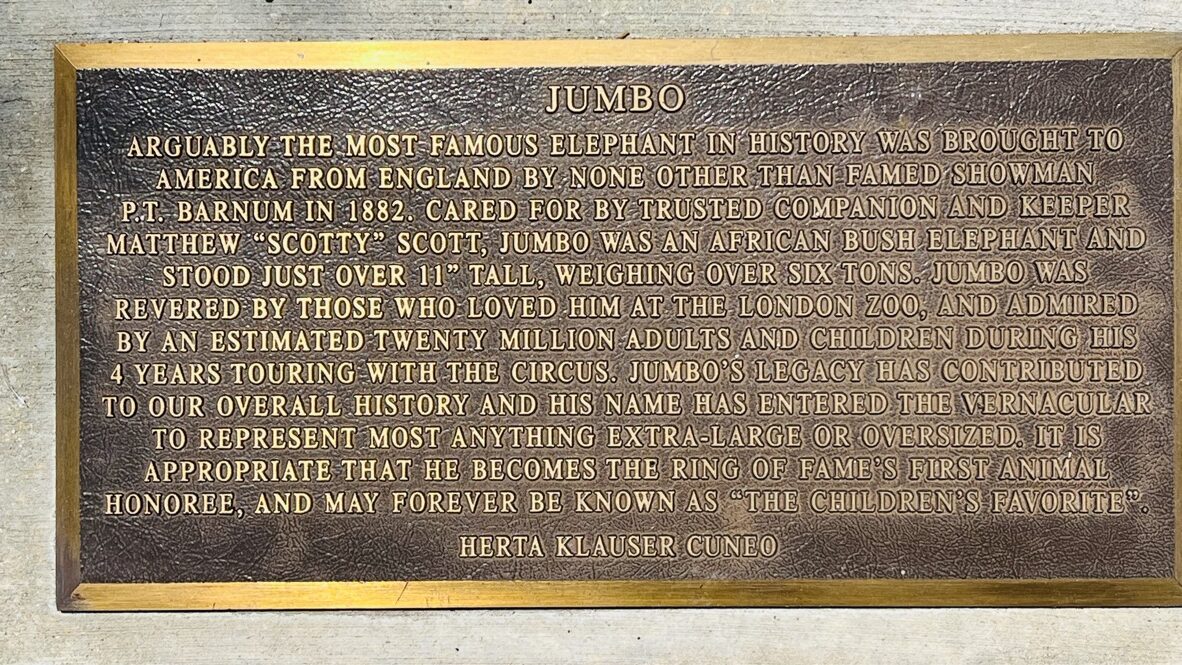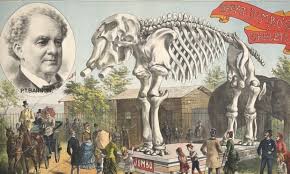
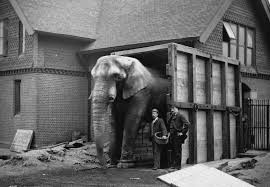
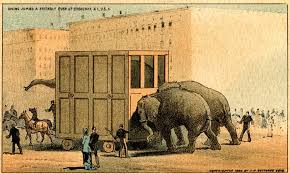
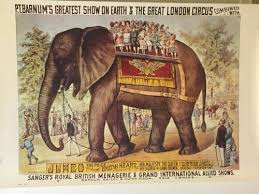

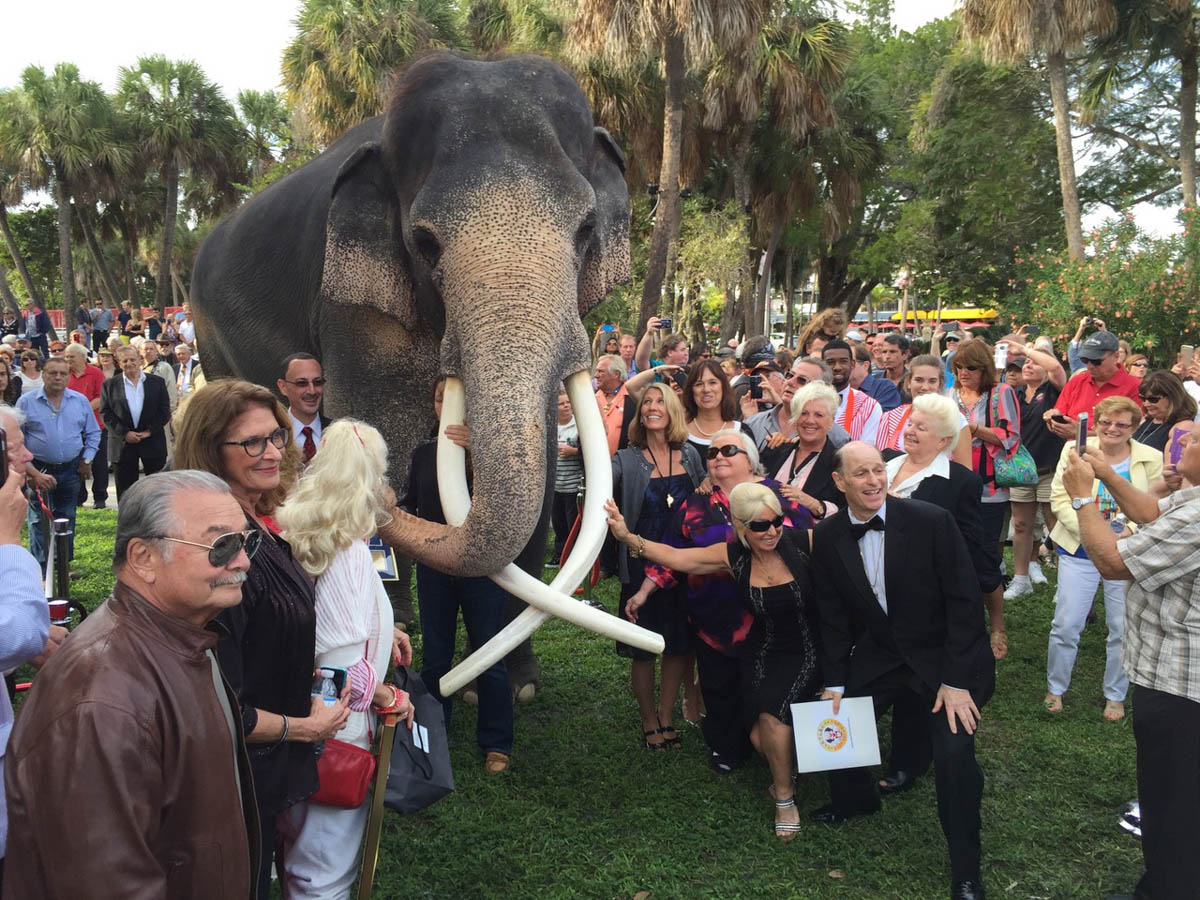
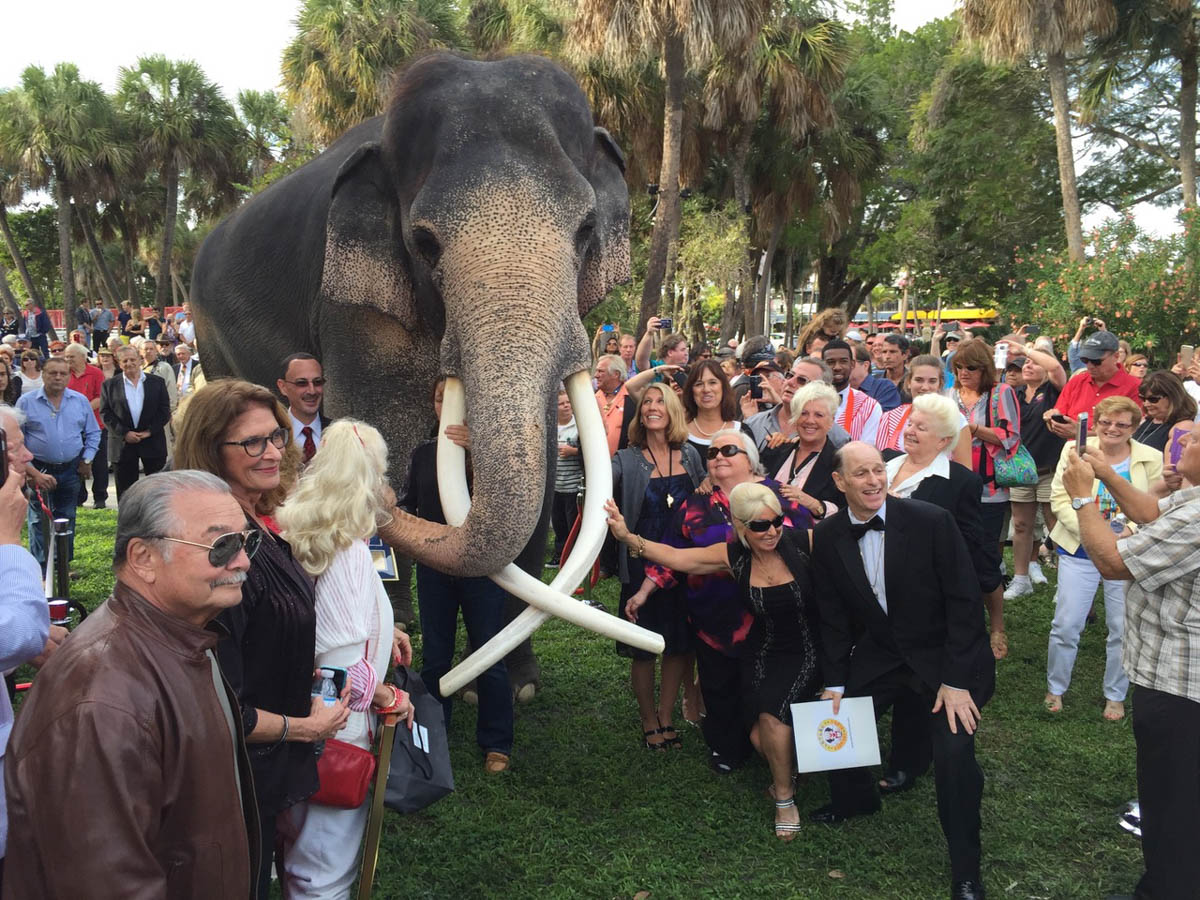
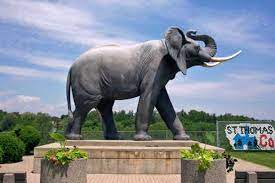
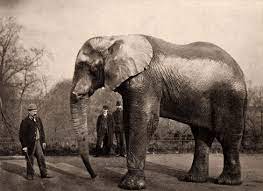
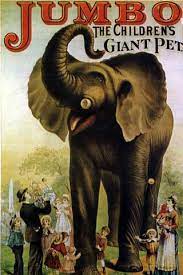
From Wikipedia:
Jumbo (about December 25, 1860–September 15, 1885), also known as Jumbo the Elephant and Jumbo the Circus Elephant, was a 19th-century male African bush elephant born in Sudan. Jumbo was exported to Jardin des Plantes, a zoo in Paris, and then transferred in 1865 to London Zoo in England. Despite public protest, Jumbo was sold to P. T. Barnum, who took him to the United States for exhibition in March 1882.
The giant elephant’s name spawned the common word “jumbo,” meaning large in size.[3] Examples of his lexical impact are phrases like “jumbo jet”, “jumbo shrimp,” “jumbo marshmallows,” and “jumbotron.” Jumbo’s shoulder height has been estimated to have been 3.23 metres (10 ft 7 in) at the time of his death,[2] and was claimed to be about 4 m (13 ft 1 in) by Barnum.
History[edit]
Jumbo was born around December 25, 1860 in Sudan,[1] and after his mother was killed by hunters, the infant Jumbo was captured by Sudanese elephant hunter Taher Sheriff and German big-game hunter Johann Schmidt.[1] The calf was sold to Lorenzo Casanova, an Italian animal dealer and explorer. Casanova transported the animals that he had bought from Sudan north to Suez, and then across the Mediterranean Sea to Trieste.
Jumbo and Matthew Scott giving a ride to children in London Zoo
This collection was sold to Gottlieb Christian Kreutzberg’s “Menagerie Kreutzberg” in Germany.[4] Soon after, the elephant was imported to France and kept in the Paris zoo Jardin des Plantes. In 1865, he was transferred to the London Zoo and arrived on 26 June.[5] In the following years, Jumbo became a crowd favorite due to his size, and would give rides to children on his back, including those of Queen Victoria.
While in London, Jumbo broke both tusks, and when they regrew, he ground them down against the stonework of his enclosure.[5] His keeper in London was Matthew Scott, whose 1885 autobiography details his life with Jumbo.[5]
“Jumbo’s pitiful refusal to leave London Zoo tugged at the nation’s heartstrings”
In 1882, Abraham Bartlett, superintendent of the London zoo, sparked a national controversy with his decision to sell Jumbo to the American entertainer Phineas T. Barnum of the Barnum & Bailey Circus for £2,000 (US$10,000).[4] This decision came as a result of concern surrounding Jumbo’s growing aggression and potential to cause a public disaster. The sale of Jumbo, however, sent the citizens of London into a panic, because they viewed the transaction as an enormous loss for the British empire. 100,000 school children wrote to Queen Victoria begging her not to sell the elephant.[a]
Jumbo’s Journey to the Docks, The Illustrated London News, 1 April 1882
John Ruskin, a fellow of the Zoological Society, wrote in The Morning Post in February 1882: “I, for one of the said fellows, am not in the habit of selling my old pets or parting with my old servants because I find them subject occasionally, perhaps even “periodically,” to fits of ill temper; and I not only “regret” the proceedings of the council, but disclaim them utterly, as disgraceful to the city of London and dishonourable to common humanity.”[6] Despite a lawsuit against the Zoological Gardens alleging the sale was in violation of multiple zoo bylaws, and the zoo’s attempt to renege on the sale, the court upheld the sale.[4] Matthew Scott elected to go with Jumbo to the United States.[5] The London-based newspaper The Daily Telegraph begged Barnum to lay down terms on which he would return Jumbo; however, no such terms existed in the eyes of Barnum.
In New York, Barnum exhibited Jumbo at Madison Square Garden, earning enough in three weeks from the enormous crowds to recoup the money he spent to buy the animal.[4][7] In the 31-week season, the circus earned $1.75M, largely due to its star attraction.[4] On May 17, 1884, Jumbo was one of Barnum’s 21 elephants that crossed the Brooklyn Bridge to prove that it was safe after 12 people died during a stampede caused by mass panic over collapse fears a year earlier.[8]
Death[edit]
Jumbo after being hit by a locomotive on September 15, 1885, in St. Thomas, Ontario
An 1889 photograph of Jumbo at Barnum Hall, the taxidermy work of Carl Akeley
Poster of Jumbo’s skeleton
Surviving fragments of Jumbo from the conflagration[9]
Jumbo died at a railway classification yard in St. Thomas, Ontario, Canada, on September 15, 1885. In those days the circus crisscrossed North America by train. St. Thomas was the perfect location for a circus because many rail lines converged there. Jumbo and the other animals had finished their performances that night, and as they were being led to their box car, a train came down the track. Jumbo was hit and mortally wounded, dying within minutes.[10][11][12]
Barnum told the story that Tom Thumb, a young circus elephant, was walking on the railroad tracks and Jumbo was attempting to lead him to safety. Barnum claimed that the locomotive hit and killed Tom Thumb before it derailed and hit Jumbo, and other witnesses supported Barnum’s account. According to newspapers, the freight train hit Jumbo directly, killing him, while Tom Thumb suffered a broken leg.[13][14]
Many metallic objects were found in the elephant’s stomach, including English pennies, keys, rivets, and a police whistle.[b]
Ever the showman, Barnum had portions of his star attraction separated, to have multiple sites attracting curious spectators. After touring with Barnum’s circus,[16] the skeleton was donated to the American Museum of Natural History in New York City, where it remains.[17][18] The elephant’s heart was sold to Cornell University. Jumbo’s hide was stuffed by William J. Critchley and Carl Akeley, both of Ward’s Natural Science, who stretched it during the mounting process; the mounted specimen traveled with Barnum’s circus for two years.[16]
Barnum eventually donated the stuffed Jumbo to Tufts University, where it was displayed at P.T. Barnum Hall there for many years. The hide was destroyed in a fire in April 1975.[17] Ashes from that fire, which are believed to contain the elephant’s remains, are kept in a 14-ounce Peter Pan Crunchy Peanut Butter jar in the office of the Tufts athletic director, while his taxidermied tail, removed during earlier renovations, resides in the holdings of the Tufts Digital Collections and Archives.[12] Jumbo is the Tufts University mascot.[19]


